#hanfu movement
Note
Please can you explain the difference of meaning between hanfu and huafu ? Sorry if you already got the question
Hi, thanks for the question, and sorry for taking ages to reply! (hanfu photo via)
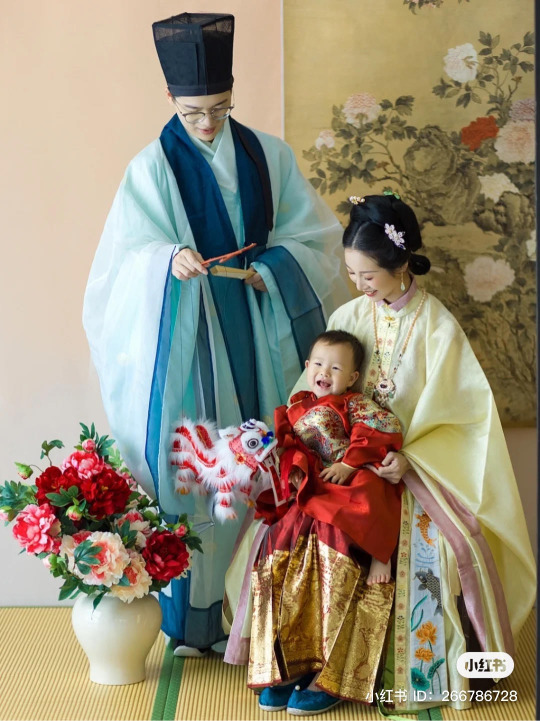
The term “hanfu” (traditional Chinese: 漢服, simplified Chinese: 汉服) literally means “Han clothing”, and refers to the traditional clothing of the Han Chinese people. “Han” (漢/汉) here refers to the Han Chinese ethnic group (not the Han dynasty), and “fu” (服) means “clothing”. As I explained in this post, the modern meaning of “hanfu” is defined by the hanfu revival movement and community. As such, there is a lot of gatekeeping by the community around what is or isn’t hanfu (based on historical circumstances, cultural influences, tailoring & construction, etc). This isn’t a bad thing - in fact, I think gatekeeping to a certain extent is helpful and necessary when it comes to reviving and defining historical/traditional clothing. However, this also led to the need for a similarly short, catchy term that would include all Chinese clothing that didn’t fit the modern definition of hanfu -- enter huafu.
The term “huafu” (traditional Chinese: 華服, simplified Chinese: 华服) as it is used today has a broader definition than hanfu. “Hua” (華/华) refers to the Chinese people (中华民族/zhonghua minzu), and again “fu” (服) means “clothing”. It is an umbrella term for all clothing that is related to Chinese history and/or culture. Thus all hanfu is huafu, but not all huafu is hanfu. Below are examples of Chinese clothing that are generally not considered hanfu by the hanfu community for various reasons, but are considered huafu:
1. Most fashions that originated during the Qing dynasty (1644–1911), especially late Qing, including the Qing aoqun & aoku for women, and the Qing changshan and magua for men. I wrote about whether Qing dynasty clothing can be considered hanfu here. Tangzhuang, which is an updated form of the Qing magua popularized in 2001, can also fit into this category. Below - garments in the style of Han women’s clothing during the Qing dynasty (清汉女装) from 秦綿衣莊 (1, 2).
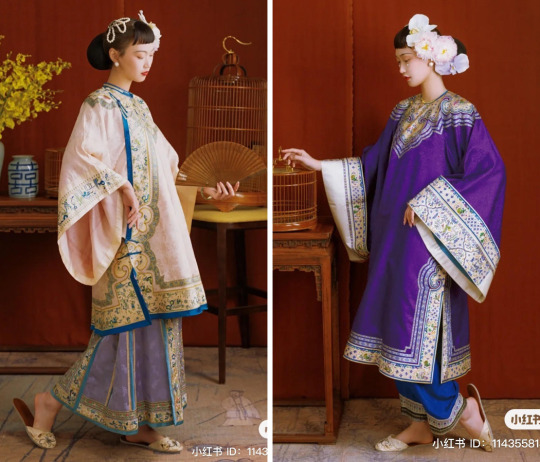
2. Fashions that originated during the Republican era/minguo (1912-1949), including the minguo aoqun & aoku and qipao/cheongsam for women, and the minguo changshan for men (the male equivalent of the women’s qipao). I wrote about why qipao isn’t considered hanfu here. Below - minguo aoqun (left) & qipao (right) from 嬉姷.

Below - Xiangsheng (crosstalk) performers Zhang Yunlei (left) & Guo Qilin (right) in minguo-style men’s changshan (x). Changshan is also known as changpao and dagua.
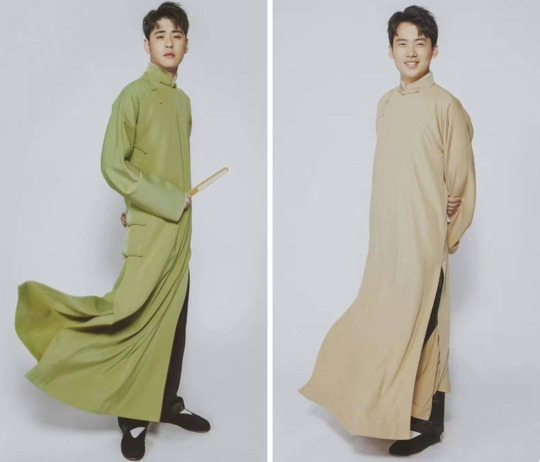
3. Qungua/裙褂 and xiuhefu/秀禾服, two types of Chinese wedding garments for brides that are commonly worn today. Qungua originated in the 18th century during the Qing dynasty, and xiuhefu is a modern recreation of Qing wedding dress popularized in 2001 (x). Below - left: qungua (x), right: xiuhefu (x).
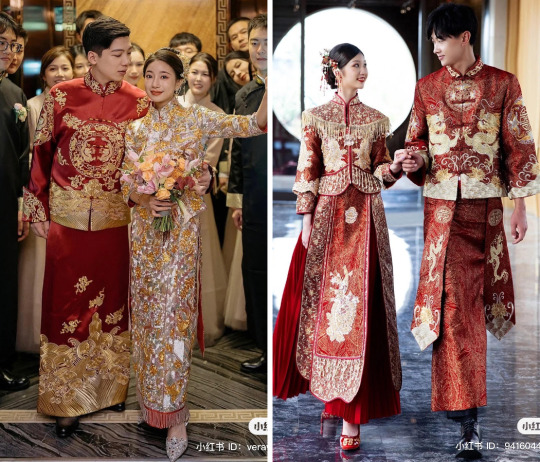
4. Modified hanfu (改良汉服/gailiang hanfu) and hanyuansu/汉元素 (hanfu-inspired fashion), which do not fit in the orthodox view of hanfu. Hanfu mixed with sartorial elements of other cultures also fit into this category (e.g. hanfu lolita). From the very start of the hanfu movement, there’s been debate between hanfu “traditionalists” and “reformists”, with most members being somewhere in the middle, and this discussion continues today. Below - hanyuansu outfits from 川黛 (left) and 远山乔 (right).

5. Performance costumes, such as Chinese opera costumes (戏服/xifu) and Chinese dance costumes. These costumes may or may not be considered hanfu depending on the specific style. Dance costumes, in particular, may have non-traditional alterations to make the garment easier to dance in. Dunhuang-style feitian (apsara) costumes, which I wrote about here, can also fit into this category. Below - left: Chinese opera costume (x), right: Chinese dance costume (x).
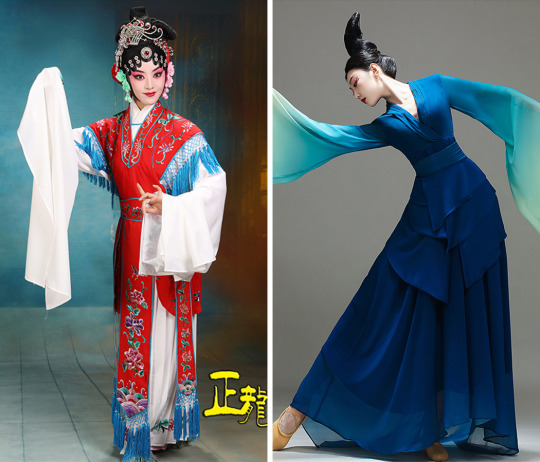
6. Period drama costumes and fantasy costumes in popular media (live-action & animation, games, etc.), commonly referred to as guzhuang/古装 (lit. “ancient costumes”). Chinese period drama costumes are of course based on hanfu, and may be considered hanfu if they are historically accurate enough. However, as I wrote about here, a lot of the time there are stylistic inaccuracies (some accidental, some intentional) that have become popularized and standardized over time (though this does seem to be improving in recent years). This is especially prevalent in the wuxia and xianxia genres. Similarly, animated shows & games often have characters dressed in “fantasy hanfu” that are essentially hanfu with stylistic modifications. Below - left: Princess Taiping in historical cdrama 大明宫词/Palace of Desire (x), right: Wei Wuxian and Lan Wangji in wuxia/xianxia cdrama 陈情令/The Untamed (x).

7. Any clothing in general that purposefully utilizes Chinese style elements (embroidery, fabrics, patterns, motifs, etc). Chinese fashion brand Heaven Gaia is a well-known example of this. Below - Chinese-inspired designs by Heaven Gaia (x).
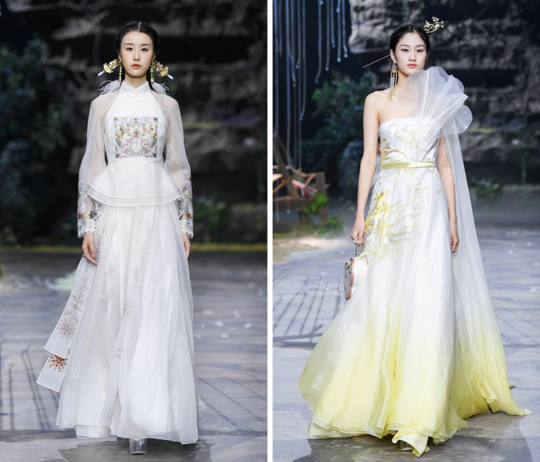
8. Technically, the clothing of China’s ethnic minorities also fit under the broad definition of huafu, but it’s rarely ever used in this way.
From personal observation, the term “huafu” is mainly used in the following situations:
1. Some large-scale events to promote Chinese clothing, such as the annual “华服日/Huafu Day”, will use “huafu” in their name for inclusivity.
2. For the same reason as above, Chinese clothing including hanfu will often be referred to as “huafu” on network television programs (ex: variety shows).
3. A few Chinese clothing shops on Taobao use “huafu” in their shop name. Two examples:
明镜华服/Mingjing Huafu - sells hanfu & hanyuansu.
花神妙华服/Huashenmiao Huafu - sells Qing dynasty-style clothing.
With the exception of the above, “huafu” is still very rarely used, especially compared to “hanfu”. It has such a broad definition that it’s just not needed in situations for which a more precise term already exists. However, I do think it’s useful as a short catch-all term for Chinese clothing that isn’t limited to the currently accepted definition of hanfu.
If anyone wants to add on or correct something, please feel free to do so! ^^
Hope this helps!
#happy 2023!#hanfu#huafu#terminology#language#hanfu movement#history#reference#ask#reply#>1000#chinese fashion#chinese culture#china
2K notes
·
View notes
Text


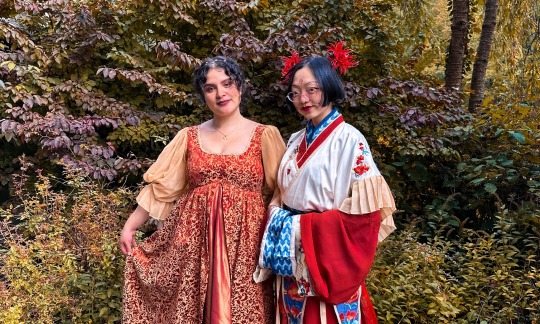


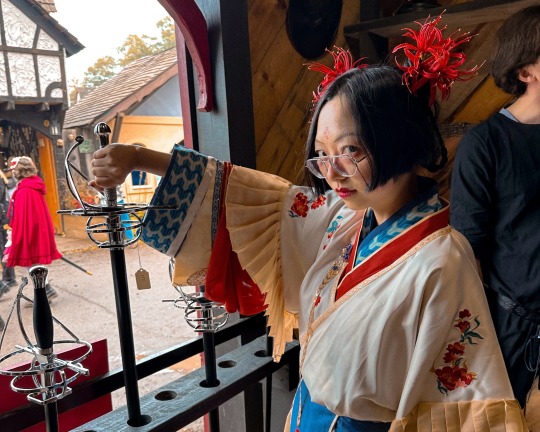


oh,, to attend a ren faire in Hanfu,,!!
had so much fun going to NY Ren Faire a while ago with my friends <33
#chinese hanfu#hanfu fashion#yovo does a face#hanfu movement#汉服#晋制#石榴花神#hanfu#new york renaissance faire#rennaissance faire
275 notes
·
View notes
Text

158 notes
·
View notes
Text
perhaps a bit of a long shot but since Ik there are a few hanfu people in the audience, does anyone know where I can find a more regional history of clothing? A lot of sources tend to go by class or time period but I can’t find many sources that focus on like ‘history of hanfu in guangdong’ or ‘clothing history in fujian’. Most of the stuff that pops up are specifically focused on ethnic minority or non-han group clothing history which is nice but not quite what i’m looking for :’(
#im on hiatus bc school has started but#just in case….#diary#hanfu#chinese hanfu#hanfu movement#tagging a lot in case there are people in the tags#chinese history#chinese clothing history#hanfu history#chinese fashion#also if anyone comes onto the og post to look. i can read chinese (and japanese to a point but i doubt theres anything lol) so if u have#any chinese sources…. pspspsps :3
55 notes
·
View notes
Text
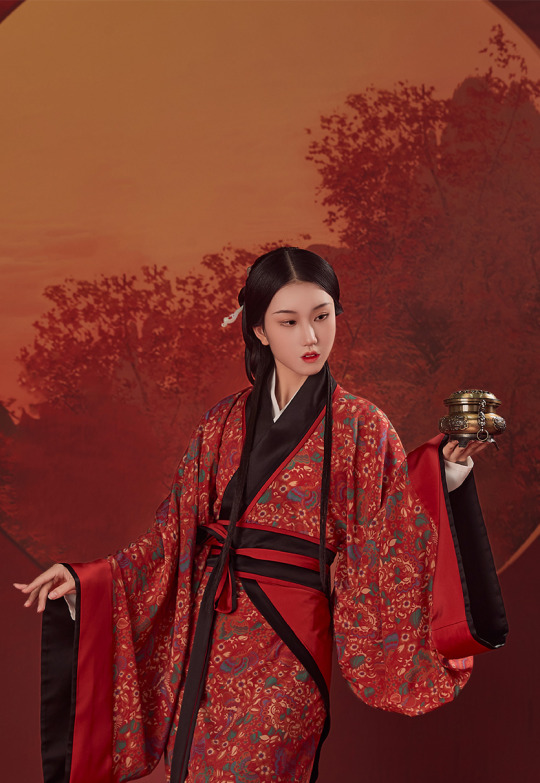
#汉服婚服#汉服运动#汉服#漢服運動#漢服#hanfu movement#hanfu#深衣#shenyi#曲裾#quju#china#chinese#chinese folk#chinese fashion#chinese culture#chinese costume#chinese outfit#chinese attire#woman fashion#east asia#asia#asian#asian folk costume#asian folk#asian fashion#asian costume#asian culture#asian outfit#asian attire
228 notes
·
View notes
Text
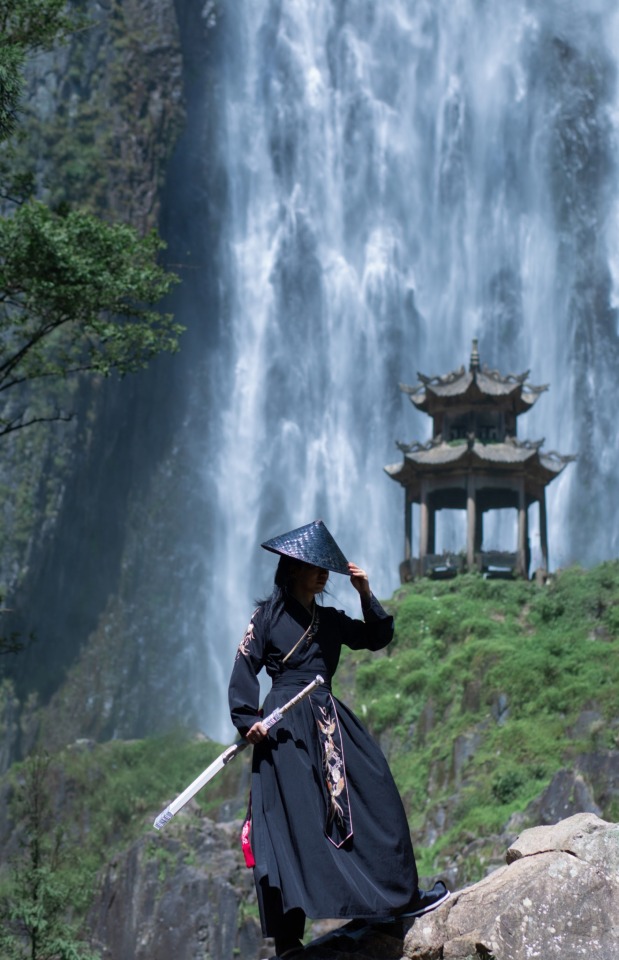

On a secret mission
64 notes
·
View notes
Note
Hello! I'm from a West European country and have been interested in learning about Chinese culture for the past few months, specially it's religions and traditional clothing, since I started reading different lgbt Chinese novels and series,like Word of honor and Tgcf, and listening to YouTubers like Xiran Jay Zhao.
I find it fascinating the difference of styles between dynasties and places, and the way it differs or reminds me of my culture. The revival that traditional clothing has had in this last few years has also deeply interested me. But there's something I'm kind of confused about.
I know that hanfu refers to traditional han clothing, and that the hanfu revival occurring is about that, but has this also affected in any shape or form the traditional clothing of other Chinese ethnic groups? By that I mean if they have also gained popularity in Chinese society or could even be included in this hanfu revival movement. What about their traditions?
And to all this, are there any works about them that could be read by English or Spanish speakers? I know there are so many different ethnic groups in the country to just be treated as one lump, but even if they talk about a specific one it would be nice to read about them.
Sorry if you have been asked/already talked about this in another post, I have tried to look around but didn't see anything (maybe I'm just blind lmao). Also sorry again for my rambling, I don't know if I'm supposed to ask though here or how to do so exactly, I've only actively used Tumblr since the end of the Summer and I'm still kind of unused to all this.
Hope you're having a nice day/night! 🥰
Hi.
I know that hanfu refers to traditional han clothing, and that the hanfu revival occurring is about that, but has this also affected in any shape or form the traditional clothing of other Chinese ethnic groups? By that I mean if they have also gained popularity in Chinese society or could even be included in this hanfu revival movement. What about their traditions?
One of the reasons that inspired the hanfu revival movement back then was a picture of a Han Chinese wearing a white t-shirt among all other ethnic groups in their colourful ethnic clothing. So no, other Chinese ethnic groups aren't included in the hanfu revival movement because they weren't prosecuted under the Tifayifu ('shaving hair and changing costume') policy, so there isn't really a need to revival because they have always been able to dress in their ethnic garments.
However, the garments of all ethnic groups are threatened by mass-produced costume-type things. Properly crafted traditional wears are often expensive on Taobao, so if they have moved away to the cities it is very difficult to get authentic garments in more reasonable price unless they travelled back to their home town. In addition, homogenization occurs because of commercialization, such as the Josean wear is heavily influence by Korean Hanbok because Hanbok is more readily available.
And to all this, are there any works about them that could be read by English or Spanish speakers? I know there are so many different ethnic groups in the country to just be treated as one lump, but even if they talk about a specific one it would be nice to read about them.
I am sorry I am not familiar with English or Spanish works... I am not even good at finding resources in Chinese. Perhaps you could check out @beehunni62 and @audreydoeskaren. @rongzhi also posted a lot of douyins of different ethnic groups under #少数民族. Not sure if @ziseviolet knows more about this.
Sorry if you have been asked/already talked about this in another post, I have tried to look around but didn't see anything (maybe I'm just blind lmao). Also sorry again for my rambling, I don't know if I'm supposed to ask though here or how to do so exactly, I've only actively used Tumblr since the end of the Summer and I'm still kind of unused to all this.
No I don't think I have been asked about this. I think I have one short reply on Dai people and that's about it.
All the best!
161 notes
·
View notes
Text
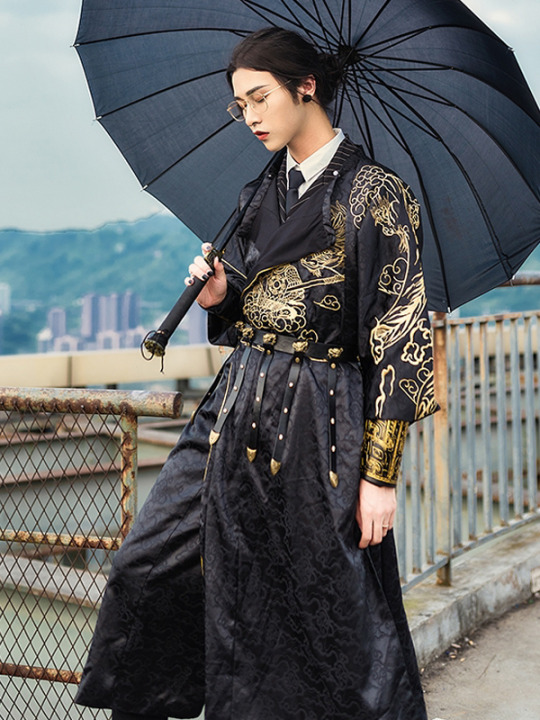

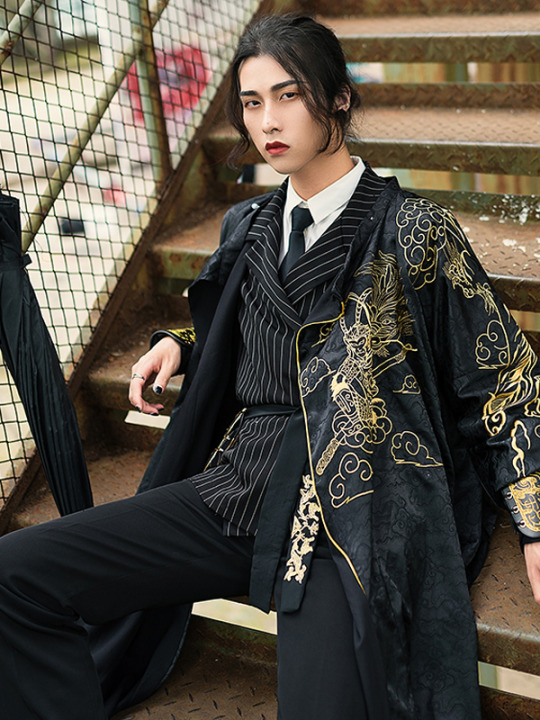

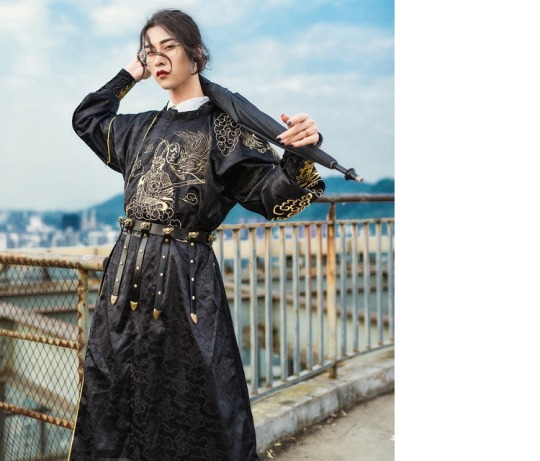

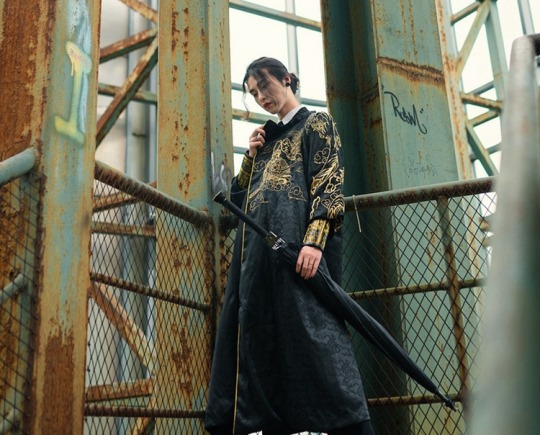
266 notes
·
View notes
Text
Hello everyone! As a Chinese person interested in hanfu, I have a question. Does anybody know what crown is the Chinese philosopher Confucius wearing in these portraits? Thank you!


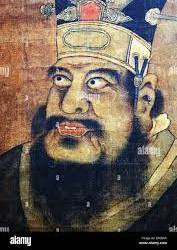

#hanfu#chinese#chinese history#ancient china#china#warring states era#warring states period#chinese fashion#hanfu accessories#hanfu movement#tang dynasty#han dynasty#qin dynasty#ming dynasty#chinese hanfu#chinese culture
172 notes
·
View notes
Text
Okay I am still pretty knew to the hanfu community but I want to know: are Hanfu season specific like kimono are? Like would it look strange to wear hanfu with spring flowers on it in fall? I've looked for information on google but I don't find the right information. Obviously kimono is influenced by Hanfu but that seasonal thing could easily be something Japanese specific.
#hanfu#hanfu movement#chinese hanfu#if im honest its for a fic#a Chinese character with ties to Japan wears a kimono and comments that its a spring kimono#i need to know if the person spoken to assumes its a weird fashion forward trend they are following#or would he know what spring styles look like and be confused by that
242 notes
·
View notes
Note
Do you think Hanfu should have a standard style? I mean, we can wear everything but there is this style which representes Hanfu, I think 齐胸襦裙 could be the best style to represent the standard because it cheap, good quality in general and comfortable! What do you think? Or it is better 袄裙?
Hi! Thanks for the question, and sorry for taking ages to reply! (image via)
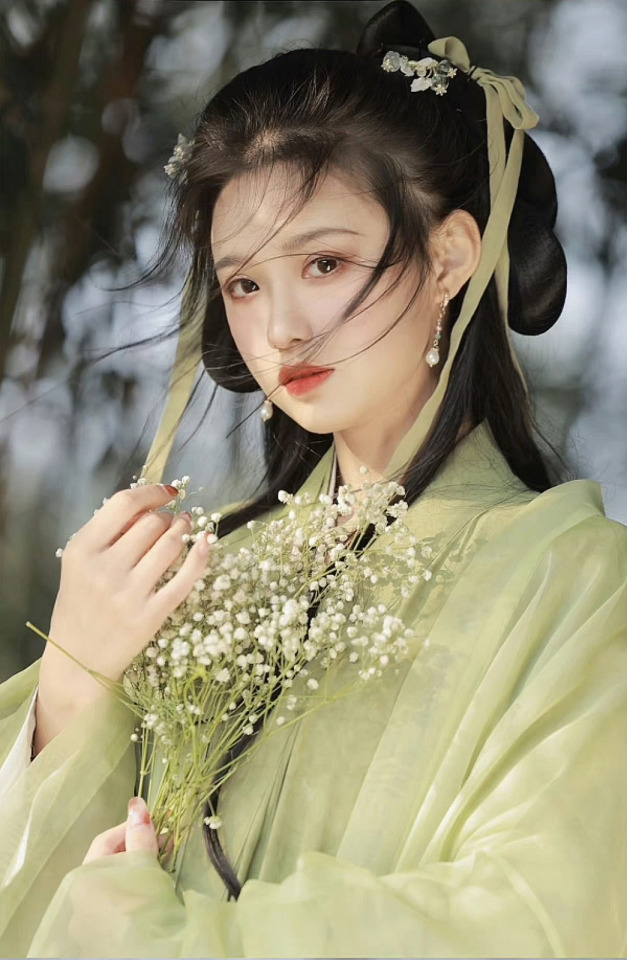
No, I personally don't think hanfu should have an all-encompassing standard style. Rather than somehow mandating a standard style for everyone, I think it's better to let individual groups, organizations, and institutions set their own standard style if they wish.
Furthermore, as I explained in my post on how I feel about the inconsistency of the hanfu revival movement, even if there was a standard style, it would be very difficult to enforce.
If I had to choose a standard style, I'd probably go with the 交领襦裙/jiaoling (cross-collar) ruqun (image via):
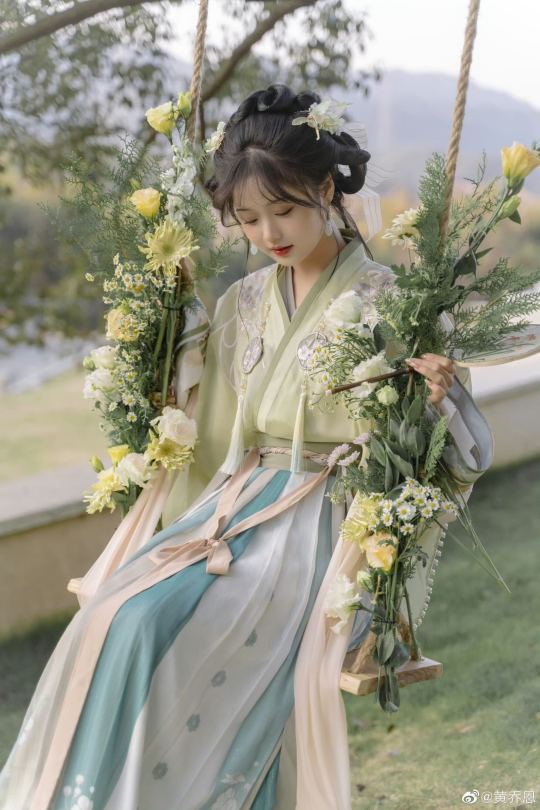
I'd choose jiaoling ruqun because it's:
the most representative style of hanfu imo
commonly depicted in media (well-known)
relatively comfortable & easy to wear
unisex
As for the two options you suggested - 齐胸襦裙/qixiong (chest-high) ruqun & 袄裙/aoqun - while qixiong ruqun is iconic as the representative women's hanfu style of the Tang dynasty, it's not as convenient to wear compared to the other two styles (image via):
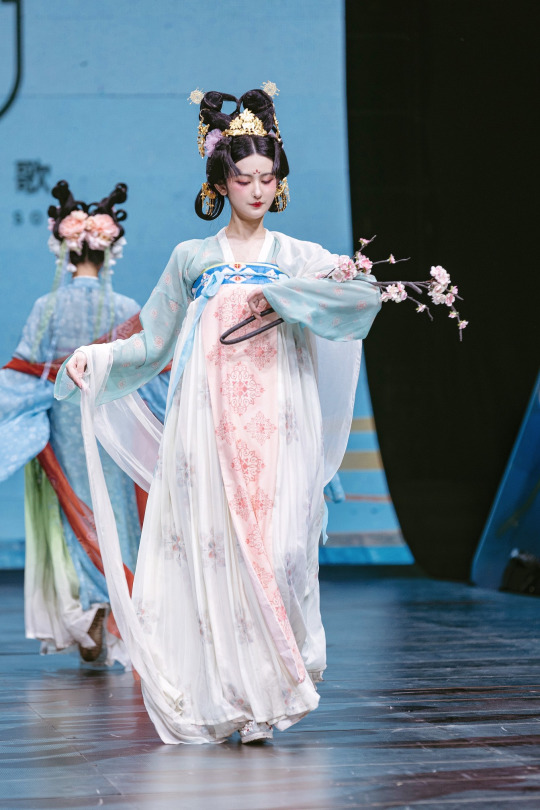
Compared to qixiong ruqun, aoqun is probably the better choice when considering convenience & comfort. It's also the representative women's hanfu style of the Ming dynasty, and thus more recent compared to other styles (image via):

With that said, I stick by my opinion that a representative standard style is not necessary for the hanfu revival.
Hope this helps!
#hanfu#jiaoling#qixiong#ruqun#aoqun#hanfu movement#ask#reply#reference#>100#chinese fashion#chinese clothing#china
157 notes
·
View notes
Text

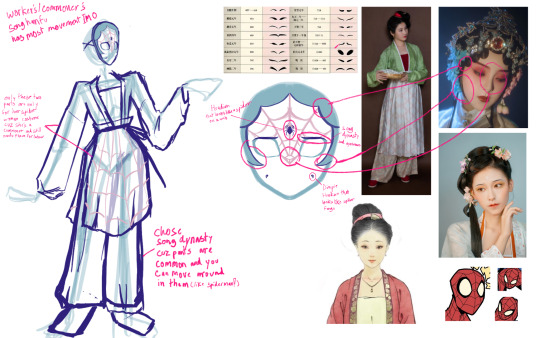
making a spidersona in set in song dynasty china, trying my hardest to be accurate to the time.
Any advice or little easter eggs i can add?
#hanfu movement#chinese hanfu#hanfu art#spidersona#into the spider verse#across the spider verse spoilers#spiderman#spider woman#song dynasty#hanfu
28 notes
·
View notes
Text
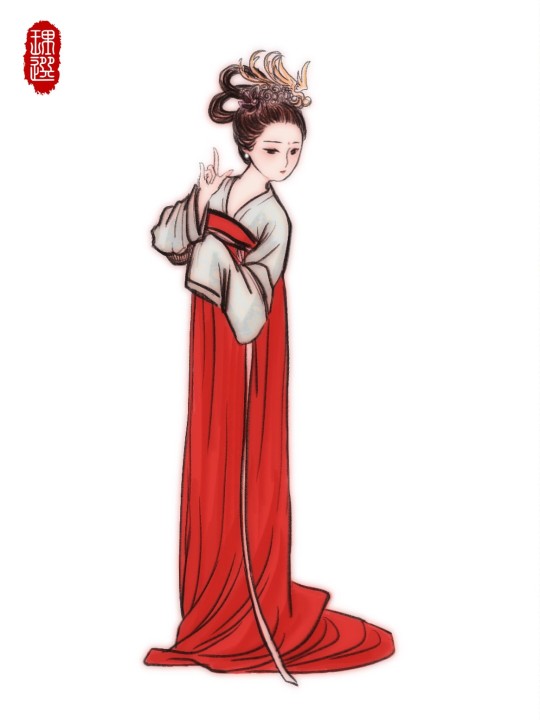
#hanfu#chinese hanfu#hanfugirl#hanfu movement#my original characters#traditional costume#digital painting#art
137 notes
·
View notes
Photo
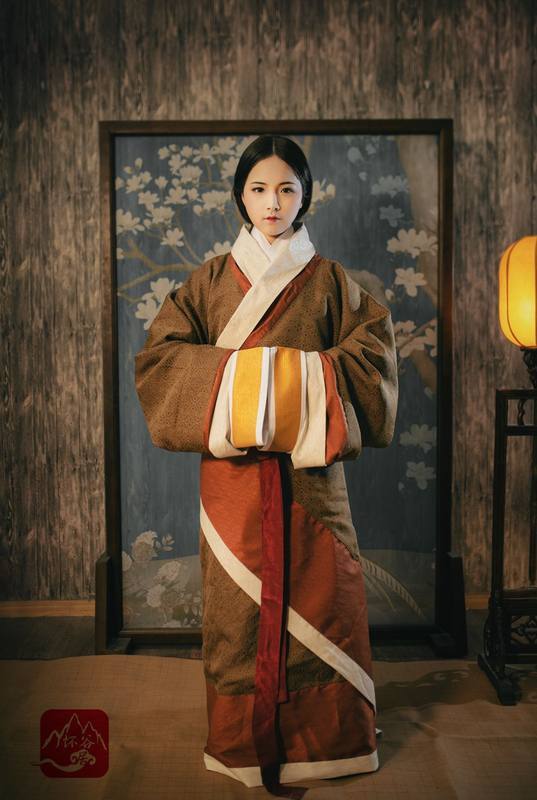

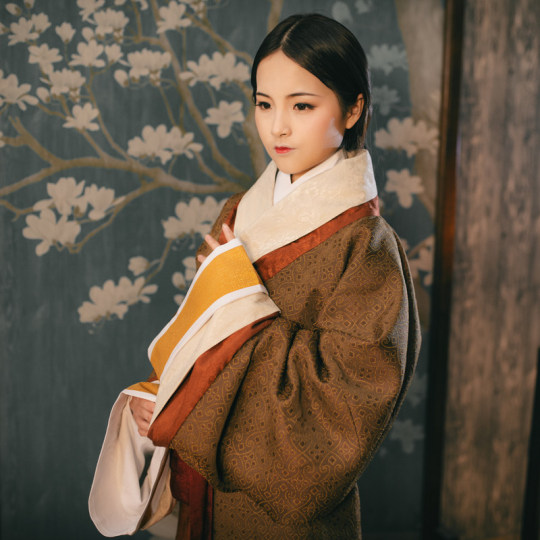
#曲裾#quju#hanfu movement#hanfu#汉服婚服#汉服运动#汉服#漢服運動#漢服#china#chinese#chinese fashion#chinese folk#chinese culture#Chinese Costume#chinese outfit#chinese attire#East Asia#woman fashion#asia#asian#asian folk costume#Asian fashion#Asian Folk#asian culture#asian costume#asian outfit#asian attire
284 notes
·
View notes
Photo
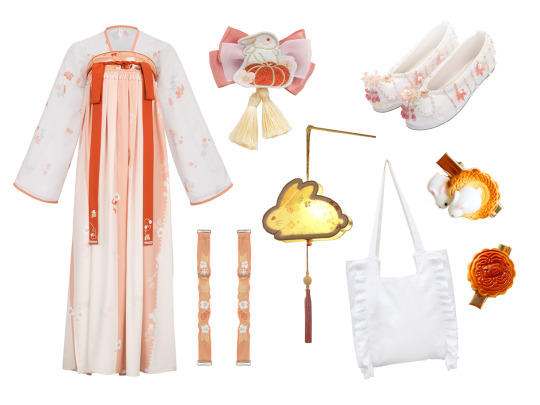
池夏【万物有灵·兔兔太南了】via Chi Xia coordination plan.
I wasn’t going to get another qixiong ruqun as they just always feel less casual. I’m also always iffy about the more themed pieces (we don’t even have 4 seasons here...) but in the end I couldn’t pass on it with Mid-Autumn festival approaching. This is a little coord I planned specifically for a lantern festival outing. Outside of the festival I hope to be able to wear it sans the mooncake clips/lantern for daily wear. Hopefully it won’t feel too out of place. Chi Xia is really killing me with their constant killer updates... my hanfu wardrobe is now over 3/4 Chi Xia. I want to get other brands a chance but they just want stop giving me gems.
62 notes
·
View notes
